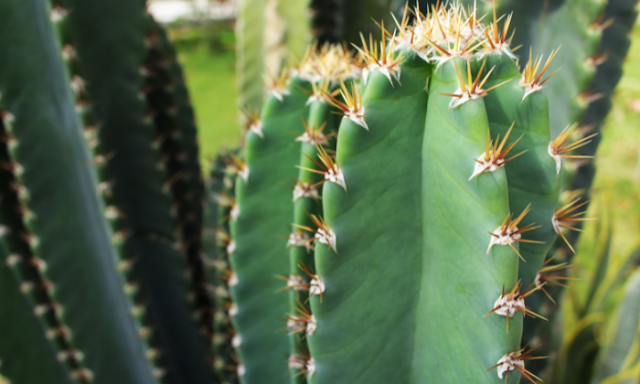San Pedro Cactus: Amazing Benefits
The San Pedro cactus (Echinopsis pachanoi) is a fast-growing columnar cactus native to the Andes Mountains in Peru. It is also known as the "Huachuma," "Achuma," or "Wachuma" cactus and has a long history of use in traditional Andean medicine and indigenous ceremonies.
The San Pedro cactus can grow up to 20 feet tall and has green, ribbed stems with small spines. It produces large, white flowers and small, edible fruit. The cactus is often used as an ornamental plant in gardens and has become popular in the cactus and succulent trade.
Usage Of San Pedro Cactus
Traditionally, the San Pedro cactus has been used for various purposes, including as a natural remedy for headaches and stomach problems. It is also believed to have psychoactive properties and has been used in indigenous ceremonies as a spiritual and emotional healing tool.
The active compounds in the San Pedro cactus are primarily mescaline and other phenethylamines, which are known to have psychoactive effects when consumed. Mescaline is a controlled substance in many countries, and the possession and use of the San Pedro cactus for psychoactive purposes are illegal in some places.
It is important to note that using the San Pedro cactus as a psychoactive substance can be risky and have harmful side effects, including anxiety, paranoia, and hallucinations. It is also not recommended for individuals with a history of mental health issues. It is always essential to consult a healthcare professional before using any plant or substance for medicinal purposes.
How to identify San Pedro Cactus
San Pedro Cactus
The San Pedro cactus (Echinopsis pachanoi) is a giant columnar cactus native to the Andes Mountains in Peru. Its distinctive characteristics can identify it:
Size and shape:
The San Pedro cactus can grow up to 20 feet tall and has a thick, cylindrical shape with ribbed stems.
Spines:
The cactus has small spines on its ribs and stems, typically yellow or white.
Flowers and Fruit:
The San Pedro cactus produces large, white flowers that bloom at the top of the plant. It also produces small, edible fruit.
Color:
The cactus has a green color, which may vary in intensity depending on the plant's age and exposure to sunlight.
If you are still determining whether a cactus is a San Pedro cactus, it is always a good idea to consult a cactus expert or a reputable source for identification. It is essential to identify plants accurately, as some cacti, including the San Pedro cactus, contain psychoactive compounds that can have adverse effects when consumed.
Cereus Repandus (Peruvian Apple)
Cereus Repandus
Cereus repandus, also known as the "Peruvian apple," is a cactus native to South America. It is a fast-growing columnar cactus that can reach heights of up to 30 feet. The cactus has green, ribbed stems with small spines and produces large, white flowers that bloom at the top of the plant. It also produces small, edible fruit that resembles apples, hence its common name.
Cereus repandus is often used as an ornamental plant in gardens and has become popular in the cactus and succulent trade. It is known for its ability to tolerate a wide range of growing conditions, making it a good choice for beginner cactus enthusiasts.
In traditional South American medicine, Cereus repandus has been used for a variety of purposes, including as a natural remedy for ailments such as headaches and stomach problems. It is also believed to have psychoactive properties and has been used in indigenous ceremonies as a spiritual and emotional healing tool.
It is important to note that using Cereus repandus as a psychoactive substance can be risky and may have adverse side effects, including anxiety, paranoia, and hallucinations. It is also not recommended for individuals with a history of mental health issues. It is always essential to consult a healthcare professional before using any plant or substance for medicinal purposes.
San Pedro Cactus Lookalikes (Imposters)
Several cactus species may resemble the San Pedro (Echinopsis pachanoi) but are not the same plant. Some common imposters include:
Trichocereus pachanoi:
This cactus is often mistaken for the San Pedro cactus because it has a similar appearance and grows in the same region. However, it is a different species and does not contain the same psychoactive compounds as the San Pedro cactus.
Lophophora williamsii:
This cactus, also known as the "peyote," is native to parts of Mexico and the southwestern United States. It is a small, button-like cactus with green, soft stems and is known for its psychoactive properties. It is often mistaken for the San Pedro cactus due to its similar appearance, but it is a different species.
Opuntia:
This is a large genus of cacti that includes many species that may resemble the San Pedro cactus. They are native to the Americas and are known for their flat, oval-shaped pads and spines. They are not psychoactive and are not related to the San Pedro cactus.
It is essential to accurately identify cacti, especially those with psychoactive properties, to avoid potential adverse effects or legal issues. If you are still determining whether a cactus is the San Pedro cactus, it is always a good idea to consult a cactus expert or a reputable source for identification.
The Amazing Benefits of the San Pedro Cactus for Mind and Body
The San Pedro cactus (Echinopsis pachanoi) is a cactus native to the Andes Mountains in South America. It has been used for centuries by indigenous people in Peru and other South America for its spiritual and medicinal properties. In recent years, it has gained popularity in the United States and Europe as a natural alternative for treating various ailments.
Here are some of the fantastic benefits of the San Pedro cactus for the mind and body:
Spiritual and psychological benefits:
The San Pedro cactus contains the psychoactive compound mescaline, which produces a strong sense of introspection, spiritual awakening, and increased creativity. Many people use it for spiritual and personal growth, meditation, and self-discovery.
Pain Relief:
The San Pedro cactus has been a natural pain reliever for centuries. It is believed to have anti-inflammatory properties that can help reduce inflammation and swelling, making it practical for treating various types of pain, including arthritis, back pain, and muscle pain.
Stress and Anxiety Relief:
The San Pedro cactus is known to have a calming and relaxing effect on the mind and body. It can help reduce stress and anxiety and may even be effective in treating depression and PTSD.
Improved Cognitive Function:
Some studies have suggested that the San Pedro cactus may have cognitive-enhancing effects, including improved memory, concentration, and focus.
Improved physical health: The San Pedro cactus is rich in antioxidants and has been shown to have several potential health benefits, including improved digestion, boosted immunity, and reduced risk of certain diseases.
It is important to note that using the San Pedro cactus for medicinal purposes is not without risks. That's why San Pedro should be used under the guidance of a qualified healthcare professional and in appropriate doses.
Conclusion:
The San Pedro cactus (Echinopsis pachanoi) and Cereus repandus (Peruvian apple) are cactus species native to South America that has been used in traditional medicine and indigenous ceremonies for their perceived psychoactive and medicinal properties.
These cacti contain compounds such as mescaline and phenethylamines that can have psychoactive effects when consumed. However, using these cacti as psychoactive substances can be risky and have adverse side effects, including anxiety, paranoia, and hallucinations. It is not recommended for individuals with a history of mental health issues. Identifying these cacti accurately and consulting a healthcare professional before using them for any purpose is essential.
FAQs
Is the San Pedro cactus illegal to possess or use?
The legal status of the San Pedro cactus varies by location. In some countries, the possession and use of cacti for psychoactive purposes is illegal due to the presence of the psychoactive compound mescaline. In other countries, the cactus may be legal to possess, but it is illegal to use it for psychoactive purposes. It is essential to check the local laws and regulations regarding the possession and use of the San Pedro cactus.
Can the San Pedro cactus be used for medicinal purposes?
The San Pedro cactus has traditionally been used in South American medicine for various purposes, including as a natural remedy for headaches and stomach problems. However, there is limited scientific evidence to support these uses, and the cactus can have adverse side effects when consumed. It is recommended to consult a healthcare professional to use the San Pedro cactus for medicinal purposes.
Can the San Pedro cactus be grown at home?
The San Pedro cactus is a fast-growing cactus that can be grown at home with proper care. It prefers a warm, sunny location with well-draining soil and should be watered sparingly. It is essential to protect the cactus from frost and freezing temperatures.
What are the potential risks of using the San Pedro cactus for psychoactive purposes?
Using the San Pedro cactus as a psychoactive substance can be risky and may have adverse side effects, including anxiety, paranoia, and hallucinations. It is not recommended for individuals with a history of mental health issues. It is essential to use caution when consuming the cactus and be aware of its potential risks and side effects.
Can the San Pedro cactus be consumed raw?
The San Pedro cactus can be consumed raw, but it is generally not recommended due to the presence of spines and other abrasive parts. It is typically prepared by boiling or drying the cactus and consuming it in a tea or capsule form. Following safe preparation methods and consulting a healthcare professional before consuming the cactus is essential.
Visit Rediscover360 for more amazing plants.






Comments
Post a Comment